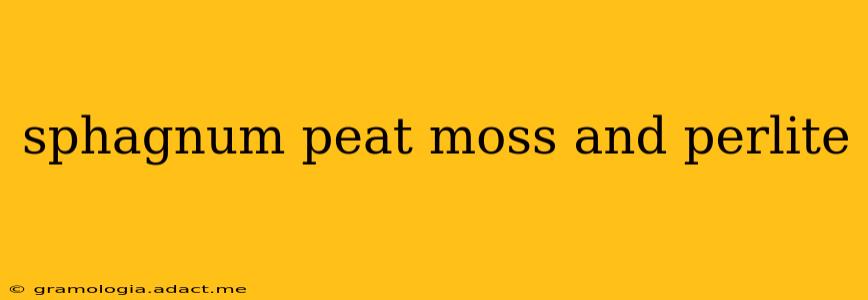Sphagnum peat moss and perlite are two popular components frequently used in potting mixes, each offering unique benefits to plant health and growth. Understanding their individual properties and how they work together is key to creating the ideal growing environment for your plants. This comprehensive guide will explore the characteristics of each material, their combined advantages, and answer common questions regarding their use.
What is Sphagnum Peat Moss?
Sphagnum peat moss is a naturally occurring material derived from partially decayed sphagnum moss, a type of moss found in bogs and wetlands. Its composition results in a soil amendment with excellent water retention properties, making it ideal for plants that prefer consistently moist soil. However, it's important to note that peat moss itself offers little to no nutrients. Its primary function is to improve soil structure and water management.
Benefits of Using Sphagnum Peat Moss:
- Excellent Water Retention: Holds water effectively, preventing the soil from drying out too quickly.
- Good Air Circulation: When properly mixed, it allows for sufficient air circulation around the roots, preventing root rot.
- Acidic pH: Contributes to a slightly acidic soil pH, beneficial for many acid-loving plants like blueberries, rhododendrons, and azaleas.
- Lightweight: Easy to handle and transport.
What is Perlite?
Perlite is a volcanic glass that has been heated to a high temperature, causing it to expand into a lightweight, granular material. Unlike peat moss, perlite does not retain water; instead, it improves drainage and aeration within the potting mix. It's an inert material, meaning it doesn't contribute nutrients to the soil.
Benefits of Using Perlite:
- Improved Drainage: Prevents waterlogging and improves root aeration.
- Lightweight: Similar to peat moss, perlite is lightweight and easy to handle.
- Inert Material: Doesn't affect soil pH or nutrient levels.
- Increases Air Circulation: Provides essential oxygen to roots, promoting healthy root development.
Why Combine Sphagnum Peat Moss and Perlite?
The combination of sphagnum peat moss and perlite creates a balanced potting medium that addresses the needs of most plants. Peat moss provides the water retention necessary to keep the roots consistently moist, while perlite ensures proper drainage, preventing the soil from becoming waterlogged and promoting healthy root growth. This synergy is crucial for optimal plant health.
How Much of Each Should I Use?
The ideal ratio of sphagnum peat moss to perlite depends on the specific plant's needs and the type of soil you're creating. A common starting point is a 2:1 or 3:1 ratio of peat moss to perlite. For plants that need exceptionally good drainage, you can increase the proportion of perlite. For plants that prefer consistently moist soil, you may want to increase the proportion of peat moss. Always research your specific plant's needs before creating a custom potting mix.
What are the alternatives to Sphagnum Peat Moss and Perlite?
While sphagnum peat moss and perlite are popular choices, there are alternatives to consider, particularly due to environmental concerns surrounding peat harvesting. Sustainable alternatives include coir (coconut fiber), composted bark, and vermiculite. These materials offer similar properties to peat moss and perlite, but with potentially lower environmental impact.
Is Sphagnum Peat Moss and Perlite good for all plants?
No, sphagnum peat moss and perlite are not universally suitable for all plants. Some plants may thrive in different soil conditions. Always research the specific requirements of your plants before mixing a potting medium.
How often should I water a plant in a peat moss and perlite mix?
Watering frequency depends on several factors, including the plant species, pot size, environmental conditions (temperature, humidity, sunlight), and the overall composition of your potting mix. It's best to check the moisture level of the soil before watering. Allow the top inch or two of soil to dry out slightly before watering thoroughly.
Can I reuse peat moss and perlite?
While you can technically reuse peat moss and perlite, it's generally not recommended. Over time, the beneficial properties of both materials may degrade, and they may become contaminated with pathogens or salts. It's often more cost-effective and beneficial to use fresh potting mix for each planting.
By understanding the individual properties of sphagnum peat moss and perlite and their synergistic effect when combined, you can create a thriving environment for your plants. Remember to always consider the specific needs of your plants when choosing a potting medium.
